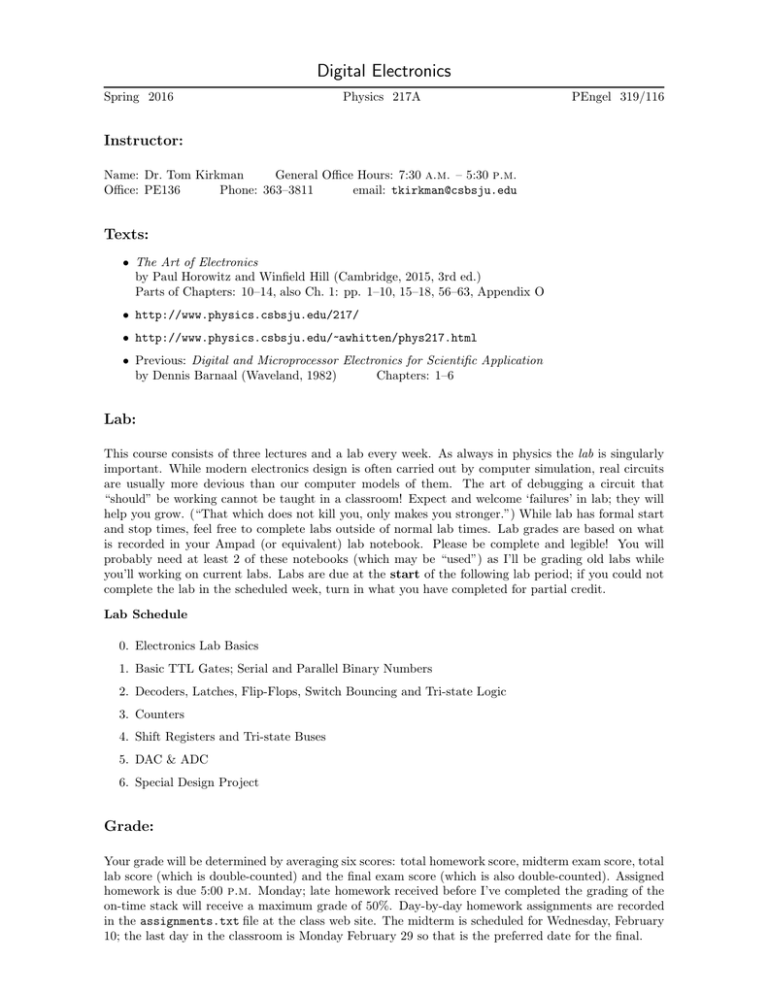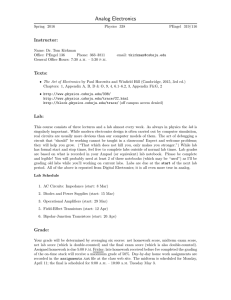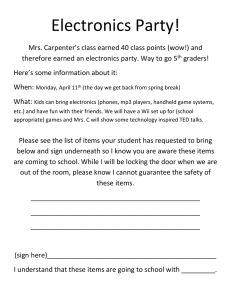Digital Electronics
advertisement

Digital Electronics Spring 2016 Physics 217A PEngel 319/116 Instructor: Name: Dr. Tom Kirkman General Office Hours: 7:30 a.m. – 5:30 p.m. Office: PE136 Phone: 363–3811 email: tkirkman@csbsju.edu Texts: • The Art of Electronics by Paul Horowitz and Winfield Hill (Cambridge, 2015, 3rd ed.) Parts of Chapters: 10–14, also Ch. 1: pp. 1–10, 15–18, 56–63, Appendix O • http://www.physics.csbsju.edu/217/ • http://www.physics.csbsju.edu/~awhitten/phys217.html • Previous: Digital and Microprocessor Electronics for Scientific Application by Dennis Barnaal (Waveland, 1982) Chapters: 1–6 Lab: This course consists of three lectures and a lab every week. As always in physics the lab is singularly important. While modern electronics design is often carried out by computer simulation, real circuits are usually more devious than our computer models of them. The art of debugging a circuit that “should” be working cannot be taught in a classroom! Expect and welcome ‘failures’ in lab; they will help you grow. (“That which does not kill you, only makes you stronger.”) While lab has formal start and stop times, feel free to complete labs outside of normal lab times. Lab grades are based on what is recorded in your Ampad (or equivalent) lab notebook. Please be complete and legible! You will probably need at least 2 of these notebooks (which may be “used”) as I’ll be grading old labs while you’ll working on current labs. Labs are due at the start of the following lab period; if you could not complete the lab in the scheduled week, turn in what you have completed for partial credit. Lab Schedule 0. Electronics Lab Basics 1. Basic TTL Gates; Serial and Parallel Binary Numbers 2. Decoders, Latches, Flip-Flops, Switch Bouncing and Tri-state Logic 3. Counters 4. Shift Registers and Tri-state Buses 5. DAC & ADC 6. Special Design Project Grade: Your grade will be determined by averaging six scores: total homework score, midterm exam score, total lab score (which is double-counted) and the final exam score (which is also double-counted). Assigned homework is due 5:00 p.m. Monday; late homework received before I’ve completed the grading of the on-time stack will receive a maximum grade of 50%. Day-by-day homework assignments are recorded in the assignments.txt file at the class web site. The midterm is scheduled for Wednesday, February 10; the last day in the classroom is Monday February 29 so that is the preferred date for the final. Questions: There is no such thing as a dumb question. Questions asked during lecture do not “interrupt” the lecture, rather they indicate your interests or misunderstandings. I’d much rather clear up a misunderstanding or further develop a topic of interest than continue a dull lecture. Remember: you are almost never alone in your interests, your misunderstandings, or your problems. Please help your classmates by asking any question vaguely related to electronics. If you don’t want to ask your question during class, that’s fine too: I can be found almost any time in my office (136) or the nearby labs. Topics: This course deals with electronic devices (called “digital devices”) whose outputs and inputs are designed to be in a handful of states. For example, the inputs and outputs of a 7432 integrated circuit (“IC”) are designed to be either slightly above ground or near +5 volts. Transitions between these two states must be “fast” or problems can develop. The +5 volt state is called high or true or 1; the near-ground state is called low or false or 0. When either of the two inputs to the gate are high, the output is high. The gate output is the logical OR of the inputs; hence, the 7432 is called an OR gate. The following “truth table” describes this function: Input A Low High Low High Input B Low Low High High Output Low High High High A Output 1 VCC B GND 8 Numbers in digital devices can be represented as a series of high and low values which represent the digits 1 and 0 in a binary (base 2) representation of the number. Thus the voltages high, low, low in three separate wires might represent the number 1002 = 410 ; high, low, high might represent 1012 = 510 ; high, high, low 1102 = 610 ; etc. In contrast to digital devices, analog devices are designed to accept and output a continuous range of voltages. Often the output is a linear function of the input (e.g., just amplified). In analog devices a number is often represented as a voltage value in a wire. Generally speaking radios (including WiFi) and amplifiers are analog, whereas computers, CDs, and digital watches are digital. Analog electronics have been around since the turn of the century; digital electronics have flourished only in the last 50 years. Most any modern device (e.g., “digital” television) is in fact a blend of both analog and digital technologies. Digital electronics reaches its ultimate complexity (and hence usefulness) in microprocessors (e.g., the Intel chip that powers most PCs). Designing microprocessor-based circuits requires both computer programming (often in assembler) and digital electronics. Unfortunately we will not have enough time to reach these interesting topics (which are covered in PHYS 358 next year). Network References: http://intel.com/ — Intel (designed usual PC chip) http://www.ti.com/ — Texas Instruments http://www.digikey.com/ — Digi-Key (electronics parts supplier) http://www.newark.com/ — Newark Electronics (larger electronics parts supplier) http://www.pbs.org/transistor/ — the discovery of transistor (history & science)




